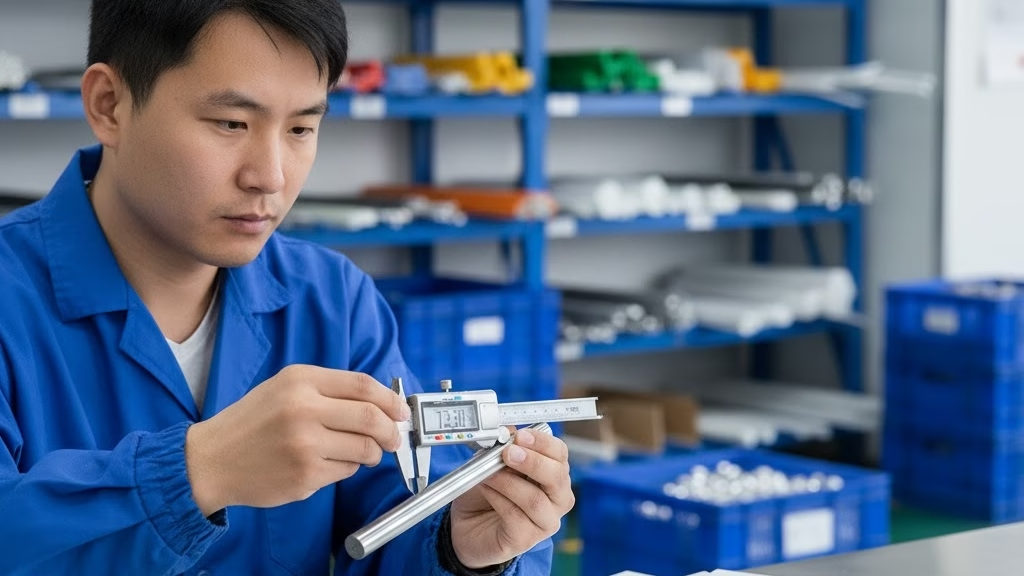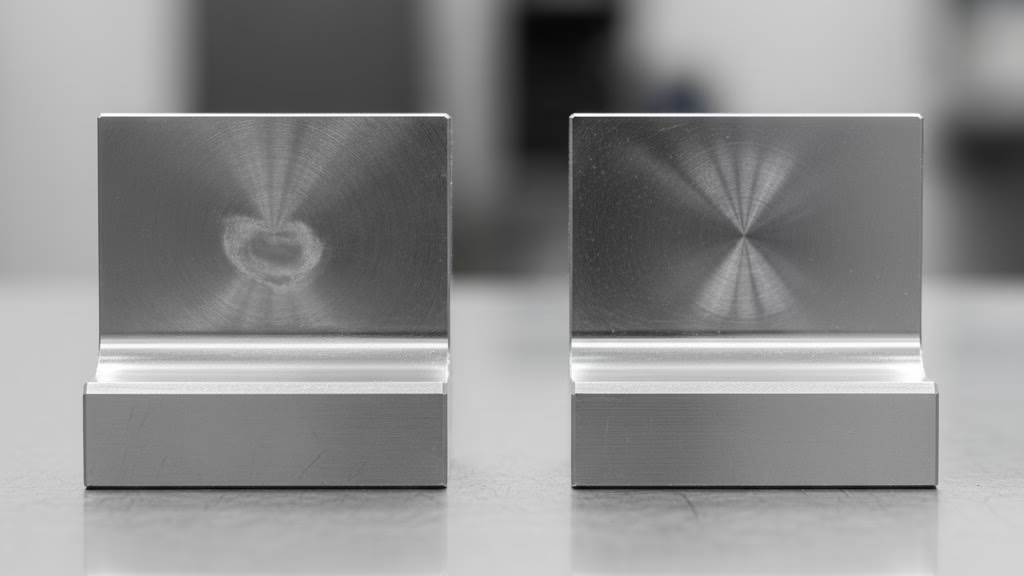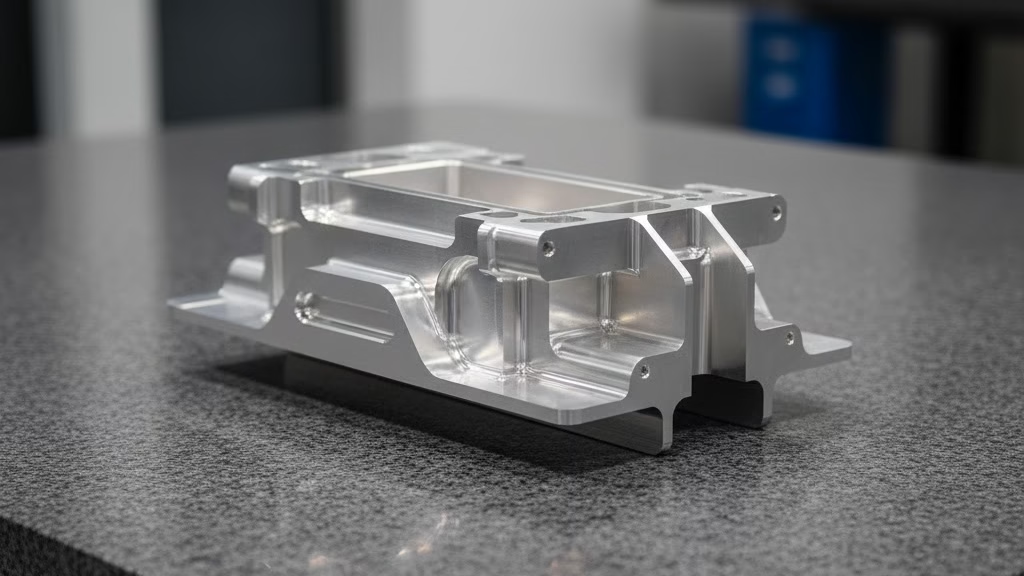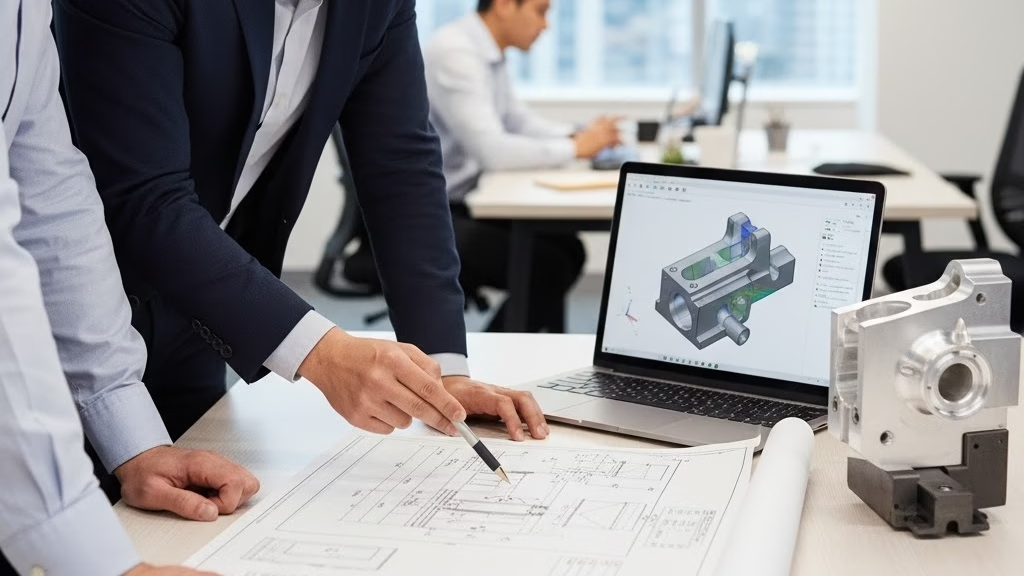Struggling to decide between plastic and metal for your next CNC machining project? Choosing the wrong material based on incomplete data can lead to costly prototype failures and critical project delays. This guide provides a proven, data-driven framework to help you make the right choice with confidence, every single time.
Choosing between plastic and metal for CNC machining depends on the application’s primary need. Metals like aluminum offer superior strength and thermal stability, making them ideal for rigid structural components. Engineering plastics like PEEK and Delrin provide excellent strength-to-weight ratios, chemical resistance, and can significantly reduce machining time and total part cost.
But the raw material is only the tip of the cost iceberg.
Keep reading to uncover the hidden manufacturing costs and Design for Manufacturability (DFM) secrets that the datasheets don’t tell you.
The Data-Driven Showdown: A Quantified Comparison

Now that we have our framework, let’s dive into the numbers. For an engineer, objective data is the bedrock of a sound decision. While datasheets can be overwhelming, focusing on a few key metrics reveals the distinct personalities of these materials.
Below is a head-to-head comparison of some of the most common materials used in CNC machining.
| Performance Metric | Aluminum (6061) | Stainless Steel (304) | Delrin® (POM) | PEEK |
|---|---|---|---|---|
| Density (g/cm³) | ~2.70 | ~8.00 | ~1.41 | ~1.32 |
| Tensile Strength (MPa) | ~310 | ~586 | ~65 | ~95 |
| Stiffness (GPa) | ~69 | ~193 | ~2.8 | ~3.6 |
| Max Temperature (°C) | ~200 | ~870 | ~90 | ~250 |
| Thermal Expansion (µm/m·°C) | ~23 | ~17 | ~100 | ~55 |
At first glance, the metals seem to dominate on strength and stiffness. But as the renowned Cambridge University professor Dr. Michael F. Ashby teaches, the best choice is rarely based on a single property.
It’s about finding the optimal combination of properties. For instance, in lightweighting applications, the critical metric isn’t just strength, but the strength-to-weight ratio. Although aluminum’s tensile strength is over three times that of PEEK, its density is more than double.
This means a high-performance polymer like PEEK can offer a competitive strength-to-weight advantage in applications where every gram counts, such as in aerospace components or robotics.
However, there’s a crucial number in that table that often gets overlooked and can become an engineer’s biggest headache: thermal expansion. This is where the difference between plastics and metals becomes starkly clear.
Let’s imagine a 150mm part that needs to fit precisely into an assembly. If its operating temperature rises by just 50°C (from room temperature to 70°C):
- The aluminum part will expand by 0.17mm.
- The Delrin part will expand by a massive 0.75mm!
That’s more than four times the change. For a part requiring tight tolerances for press-fits or bearing alignment, a dimensional shift of that magnitude is the difference between a functional product and a pile of scrap. This single calculation highlights why understanding the full scope of material properties, beyond just the mechanical ones, is absolutely critical.
It’s not just about how a material performs on day one, but how it behaves throughout its entire operational lifecycle.
What Your Purchasing Department Doesn’t See
When it’s time to talk money, the conversation often starts and ends with the price per kilogram of the raw material. Your purchasing department might see that ABS is significantly cheaper than Polycarbonate (PC) and push for the lower-cost option. But as an engineer, you know the true cost of a component is far more complex.
It’s like an iceberg: the material cost is the small, visible tip, while the massive, dangerous bulk lies hidden beneath the surface.
This hidden part of the iceberg is the total cost of ownership, and it’s where projects can run aground. Let’s break down what’s lurking below:
Machining Time Cost
This is arguably the biggest hidden factor. Machining a part from stainless steel, with its toughness and poor machinability rating, can easily take twice as long as machining the exact same geometry from Delrin.
If your machine shop rate is $75 per hour, a part that takes 60 minutes in steel versus 20 minutes in Delrin has a machining cost difference of $50 right there—a difference that can quickly eclipse any savings on the raw material itself.
Post-Processing Costs
Does your aluminum part need anodizing for corrosion resistance and aesthetics? That’s an extra step, extra time, and extra cost.
Many high-performance plastics, on the other hand, are inherently corrosion-resistant and can be molded in color, eliminating this entire stage and its associated expenses.
Failure Cost
This is the most dangerous part of the iceberg. We once worked with a client developing a new electronic device with a small internal heating element. To save money, they insisted on using ABS for a mounting bracket, against our advice.
The initial prototypes worked, and 500 units were produced. However, during the final quality control testing, the accumulated heat caused the ABS brackets to soften and deform, leading to critical component misalignment and a 100% failure rate.
The “savings” from choosing the cheaper plastic were instantly wiped out. They lost the entire cost of the 500 failed parts, faced significant production delays, and had to pay for a rush order of new brackets made from the correct, more heat-resistant material.
This real-world case demonstrates a crucial lesson: the most expensive material choice you can make is often the one that fails.
How to Design for Your Chosen Material

There’s no feeling more frustrating for an engineer than spending days perfecting a design, only to have a manufacturer come back and say, “We can’t make this,” or “We can, but it’s going to cost you a fortune.” This painful gap between your design and its real-world manufacturability is often where projects stall.
The root cause? A failure to apply Design for Manufacturability (DFM) principles specific to your chosen material. Designing for plastic is fundamentally different from designing for metal.
As Greg Paulsen, Director of Application Engineering at Xometry, often points out, engineers can fall into the trap of simply trying to machine a design optimized for aluminum out of a plastic like Delrin. This direct substitution rarely succeeds. To avoid this, you need to think in the native language of the material you’ve chosen.
Here are a few critical DFM considerations:
Wall Thickness and Corner Radii
With metals, you can often get away with thin walls and sharp internal corners. Try that with a plastic part, and you’re inviting trouble. Plastics require more uniform wall thicknesses to prevent issues like warping and sink marks. Furthermore, sharp internal corners create stress concentrations.
A generous internal radius (a good rule of thumb is at least 0.5 times the wall thickness) is essential to distribute stress and prevent cracking, a step that’s good practice in metals but absolutely critical in polymers.
The Tolerance Trap
We frequently see drawings for plastic parts with a title block that calls for a blanket tolerance of ±0.05mm on all dimensions—a common practice in metal machining. While achievable, holding such a tight tolerance across an entire plastic part is incredibly expensive.
Due to plastic’s high thermal expansion and lower rigidity, our machinists must slow down cutting speeds, use specialized tooling, and perform more frequent inspections. This dramatically increases machine time.
A better approach is to apply tight tolerances only to mission-critical features, like a bearing bore or a press-fit surface. For non-critical dimensions, relaxing the tolerance to a more standard ±0.15mm can often cut the part cost by 30-50% without any functional sacrifice.
Designing Threads
In a metal part, tapping a thread directly into the material is standard practice. In a plastic part, this can be a point of failure, especially if the screw will be removed and reinserted multiple times.
For superior durability, designing a recess for a threaded insert is the professional-grade solution. These metal inserts provide strong, reliable machine threads that can withstand repeated use, ensuring the longevity of your assembly.
Ready to Machine High-Performance Plastics?
Whether you need the extreme performance of PEEK or the versatility of Delrin, our precision CNC machining services deliver the tight tolerances your project demands. Let our experts turn your complex plastic designs into reality.
A Practical Decision Tree
All this data is great, but how do you apply it to the project sitting on your screen right now? To make this guide truly practical, let’s translate theory into action. Below is a simple, question-based decision tree designed to help you quickly narrow down your options based on your single most important design driver.
| If Your Top Priority Is… | Primary Material Candidates | Key Consideration |
|---|---|---|
| Lightweighting | PEEK, 7075 Aluminum, Carbon-Fiber Nylon | Calculate strength-to-weight ratio; consider hybrid designs. |
| Chemical/Moisture Resistance | PEEK, PVC, Teflon (PTFE) | Plastics avoid the need for secondary coatings. Beware of stress cracking. |
| Rapid Prototyping Speed | Delrin (POM), Nylon, ABS | Prioritize fast machining and iteration over final material properties. |
- Is your absolute top priority lightweighting?
This is the primary concern for aerospace, drone, and robotics applications. But before you default to aluminum, ask a follow-up question: Does the part also require high structural strength?
- If YES (high strength is critical): You are in the realm of high-performance materials. Your top candidates are 7075 Aluminum for its excellent strength-to-weight ratio, or advanced polymers like PEEK and carbon-fiber-reinforced Nylon. This is also the perfect time to think beyond a single material. Could a hybrid design work? Consider a core structural frame made from aluminum, with integrated components like bearing surfaces or motor mounts machined from self-lubricating, vibration-dampening plastics. This advanced approach optimizes the entire assembly, not just a single part.
- If NO (strength is secondary to weight): Your options open up considerably. General-purpose engineering plastics like ABS and Polycarbonate (PC) offer significant weight savings over any metal and are a cost-effective choice for housings, covers, and non-load-bearing components.
- Will your part operate in a harsh chemical or high-moisture environment?
For medical devices that undergo repeated sterilization or industrial parts exposed to corrosive fluids, material resistance is non-negotiable.
- If YES: This is where plastics truly shine. Metals like aluminum and even some grades of steel will require protective secondary coatings (like anodizing) which can be scratched or wear away. Polymers such as PEEK, PVC, and Teflon (PTFE) offer outstanding inherent resistance to a wide range of chemicals. For applications requiring both chemical resistance and transparency, Polycarbonate (PC) can be a good choice, but be wary. As we’ve seen in real-world cases, a material’s chemical resistance can plummet when it’s under mechanical stress—a phenomenon known as environmental stress cracking. Always consider the complete operating conditions.
- Is your goal rapid, low-cost functional prototyping?
In the early stages of development, speed is everything. The goal isn’t to create a perfect, production-ready part, but to quickly validate a design and iterate.
- If YES: This is the ideal use case for easily machinable, low-cost plastics. Materials like Delrin (POM) and Nylon are fantastic for this purpose. They cut quickly, are relatively inexpensive, and are strong enough to test form, fit, and function. The speed advantage here is immense. In the time it takes to get one or two metal prototypes made, you could have tested five or six iterations in plastic, allowing you to refine your design faster and get to market quicker.
Choosing a Partner Who Prevents Problems

You’ve done the research, weighed the options, and created a design optimized for your chosen material. Now you face one last crucial step: selecting a manufacturing partner. It can feel like a leap of faith. Many CNC shops claim they can machine dozens of materials, both plastic and metal.
But the reality is, true expertise in plastic machining is a separate and distinct discipline from metal machining.
A shop that primarily cuts steel might not understand the nuances of working with polymers. They might use the wrong cutting tools, apply excessive clamping force that warps the part, or be completely unaware of post-machining processes like annealing to relieve internal stress in plastics like Polycarbonate.
This “expertise gap” is a hidden risk that can lead to parts that are out of tolerance, visually flawed, or fail prematurely in the field.
So how do you identify a true expert? You need to ask the right questions—questions that go beyond a simple “Can you make this?”
Before you send out your next RFQ, ask your potential supplier these questions to vet their real-world experience:
- “For a high-tolerance part in PEEK, how do you manage and compensate for thermal expansion during the machining process?”
- “What type of tooling do you typically use for glass-filled plastics to manage abrasion and ensure a good surface finish?”
- “Can you describe your process for annealing Polycarbonate or Ultem parts to prevent stress-cracking?”
A true specialist will answer these questions with confidence and detail. They’ll talk about specific tool geometries, cooling strategies, and their quality control processes. A generalist will likely give you a vague or uncertain response.
Ultimately, the right partner does more than just cut material; they provide value before the machine is ever turned on. They act as an extension of your engineering team, reviewing your design for manufacturability, offering material suggestions, and helping you foresee and prevent problems.
This collaborative approach is the difference between simply buying a part and making a strategic investment in your product’s success.
Making the right choice in the Plastic vs. Metal CNC Machining debate is about having a clear framework, understanding the true costs, and designing for your material. But it’s also about finding a partner with the proven experience to bring your design to life flawlessly.
Don’t leave your project to chance. Upload your design, and let our engineers provide a free, expert DFM analysis and material consultation to ensure your parts are a success from the start.
Ready to Start Your Next Project?
You have the design. We have the precision machining expertise. Let our engineers partner with you to deliver high-quality metal and plastic parts that meet your exact specifications.
References & Notes
[1] Ashby Charts: The material property charts, often called Ashby charts, were developed by Dr. Michael F. Ashby of Cambridge University. They are a powerful tool for visualizing material properties and enabling systematic selection based on performance indices like strength-to-weight ratio.
[2] Environmental Stress Cracking (ESC): A common cause of failure in thermoplastic polymers, ESC occurs when a material is subjected to both mechanical stress and a chemical agent. The combination can cause brittle failure at stress levels that the material would normally withstand.




